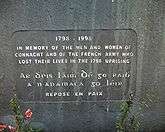Battle of Killala
| Battle of Killala | |||||||
|---|---|---|---|---|---|---|---|
| Part of the United Irishmen Rebellion | |||||||
| |||||||
| Belligerents | |||||||
|
|
| ||||||
| Commanders and leaders | |||||||
|
Lieut. Col. Charost, Capt. Bellew, Richard Bourke, Roger MacGuire, Henry O'Keon | General Trench | ||||||
| Strength | |||||||
|
900[1]–4,000[2] Irish, 4 French officers | 1,200 | ||||||
| Casualties and losses | |||||||
| 400–500 dead | ? | ||||||
The Battle of Killala was an engagement during the Irish Rebellion of 1798. It was fought on Sunday, 23 September 1798, between forces of the British Crown and a combined force of Irish rebels and a small number of French troops at Killala, County Mayo, Ireland.
Background
On the day before the battle, the advance of the British army was visible miles from Killala – as it was marked by smoke from houses and cabins burned along the route.[3] Prior to the battle, Rebels and refugees began pouring into Killala – especially from the direction of Ballina. The morning was marked by heavy rainfall, but this cleared before noon.[4] The French present at the battle included 4 officers only – Charoust, Boudet, Ponson and Truc. Truc had arrived on the morning of the battle from Ballina.[4]
The battle
The main body of Rebels occupied rising ground about a mile outside the town of Killala, on the road to Ballina. They positioned themselves behind low stone walls on each side of the road, which acted as breastworks. Other Rebels were positioned elsewhere near the town, correctly anticipating that the British would split their forces for the attack. The British force approached the town in two divisions, each from a different direction. One of these divisions approached in the direction of where the Rebels were stationed on the Ballina road and a sharp engagement took place when the two sides met. This lasted for about twenty minutes, until the Rebels fled back into the town. They were pursued by the British troops as they did so and, as a result, many Rebels were killed – both within the town and in the fields surrounding it.
Aftermath

The defeat was the last major engagement of the 1798 rebellion. Killala had remained for 32 days in the hands of the Rebels and French.
Many Rebels were killed on the day after the battle also, as the army searched the town and surrounding countryside for fugitives. The British forces burned many houses in the area. On both days, a number of innocent civilians and loyalists were also killed.[5] The French officers surrendered – afterwards they were sent to Dublin, and from there to London. Henry O'Keane, though an officer in the French army,[6] was not treated as such when captured. O'Keane was sent to Castlebar, where he was tried by Court martial. He was expelled from and forbidden ever to return to British territories.[7]
Courts martial began the day after the battle. The proceedings took place at the house of Owen Morrisson in the town.[8] Two Rebel leaders, Richard Bourke and Captain Bellew, were tried on Monday evening and found guilty. They were executed the next morning in the park behind the castle.[9][10] Another prominent Rebel, Roger MacGuire, was transported to Botany Bay. MacGuire's father was hanged.[11] Courts martial and executions of other Rebels continued for a week.[12] Seventy-five prisoners were tried at Killala.
The Church of Ireland Bishop of Killala and Achonry, Joseph Stock, left the most detailed eye-witness account of the battle. It was published in 1800.
References & footnotes
- ↑ Gordon, p. 302.
- ↑ Musgrave, Vol. 2., p. 188.
- ↑ Stock, p. 135.
- 1 2 Stock, p. 142.
- ↑ Maxwell, p. 247.
- ↑ Therefore, there were really 5 French Officers present at the battle – if O'Keane is included.
- ↑ Stock, pp 71 – 74.
- ↑ Stock, p. 75 & p. 164.
- ↑ Stock, pp 164–165.
- ↑ Maxwell, p. 251.
- ↑ Stock, p. 166.
- ↑ Teeling, p. 230.
Sources
- Gordon, James B. History of the Rebellion in Ireland in the year 1798, &c. London, 1803.
- Gribayédoff, Valerian. The French invasion of Ireland in '98. Leaves of unwritten history that tell of an heroic endeavour and a lost opportunity to throw off England's yoke. New York: Charles P. Somerby, 1890.
- Maxwell, William Hamilton. History of the Irish Rebellion in 1798; with Memoirs of the Union, and Emmett's Insurrection in 1803. 7th edition. London: Bell and Daldy, 1866.
- Musgrave, Richard. Memoirs of the Different Rebellions in Ireland. Vol. 2 of 2. Third edition. Dublin, 1802.
- Stock, Joeseph. A Narrative of what passed at Killalla, in the County of Mayo, and the parts adjacent, during the French invasion in the summer of 1798. Dublin & London, 1800.
- Teeling, Charles Hamilton. Sequel to Personal Narrative of the "Irish Rebellion" of 1798. Belfast: John Hodgson, 1832.
Coordinates: 54°12′45″N 9°13′19″W / 54.2125°N 9.2219°W